Category Archive: Uncategorized
Ball and roller bearing internal clearance is the total distance the inner or outer ring of a bearing can move when the opposite ring is fixed. A certain clearance is needed to allow for adequate movement between rings. Your bearing clearance can improve or hinder overall bearing performance. Over time, it can also affect the lifespan of the bearing.
Let’s examine what bearing internal clearance is, why it matters, and how to select the correct clearance for your needs.
Why Does Bearing Internal Clearance Matter?
Bearing internal clearance is critical to maintain the bearing’s efficiency in operations. The internal clearance determines whether rolling elements move in a rolling or sliding motion, which affects the bearing’s mechanical efficiency.
There are two types of internal clearance:
- Radial Internal Clearance. Movement perpendicular to the bearing axis
- Axial Internal Clearance. Movement along the bearing axis
Radial internal clearance can be calculated by taking the outer ring’s average raceway diameter and subtracting the inner ring’s average raceway diameter, then doubling and subtracting the ball diameter. Axial play, measured along the bearing axis, is typically about ten times the radial play value.
Proper internal clearance is critical for maintaining a stable load distribution within the bearing. This directly affects bearing performance, reducing running noise and controlling vibration levels.
How Much Can Bearing Internal Clearance Be?
The internal bearing clearance should be as low as possible, ideally a few microns or even zero after assembly. The correct clearance degree can be determined by assessing a few project-specific factors.
Factors influencing bearing internal clearance include:
- Application
- Temperature
- Load Conditions
Choosing the correct internal clearance ensures the bearing performs optimally, reducing the risk of premature failure and enhancing overall efficiency.
Related Reading:
Bearing Internal Clearance: C0 vs. C3
Understanding the differences between C0 and C3 clearances can help you find the right bearing for your application:
- C0 (or CN). The standard clearance for typical applications with recommended fits and normal operating conditions. This clearance isn’t usually marked on the bearing.
- C3. A greater clearance compared to C0. This clearance is used when higher thermal expansion or specific load conditions require more space within the bearing.
Each clearance type suits different operational needs. C3 clearances, for example, are often used in high-speed or high-temperature environments where additional room is needed to accommodate thermal expansion without compromising performance.
Choose Emerson Bearing for Precision-Machined Bearings
Emerson Bearing has a rich history in the bearing industry, providing high-quality, precision-machined bearings for a range of applications. Our expertise and commitment to quality make us a reliable partner for your bearing requirements.
With a range of products including ball bearings, ceramic bearings, roller bearings, linear motion bearings, and super precision bearings, Emerson Bearing is ready to help you find the perfect solution for your needs.
Visit our Contact Us page or Request a Quote form to get started; we’ll work to provide the precision and quality you need.
Bearings improve efficiency in linear and rotational movements by reducing friction and supporting loads. The materials used to make bearings impact the applications to which they are best suited and how they perform.
Ceramic hybrid and steel bearings are common choices in many industrial applications. Here, we’ll look at both in detail, along with the strengths and typical applications of each. We’ll also look at considerations for selecting the right bearing for your needs.
Understanding Ceramic and Ceramic Hybrid Bearings
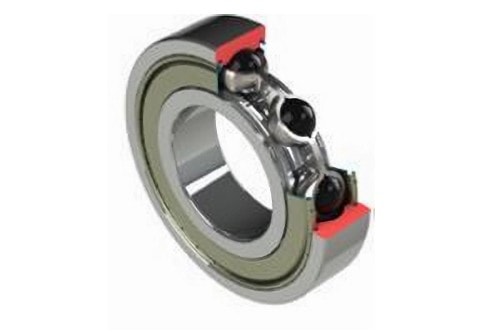
Full ceramic bearings are made entirely of ceramic materials, including the balls and races. They can be more vulnerable to impact and thermal stress; therefore, ceramic hybrid bearings are more commonly used today. Hybrids use ceramic and steel components to provide extra durability. Ceramic hybrid bearings consist of ceramic rolling elements with steel cages and races.
Rolling elements can be made from different ceramic materials depending on the requirements of an application. Materials include:
- Silicon nitride (Si3N4)
- Aluminum oxide (Al2O3)
- Zirconium oxide (ZrO2)
- Silicon carbide (SiC)
Advantages of Ceramic Hybrid Bearings
Because they combine ceramic and steel materials, ceramic hybrid bearings have the advantages of both materials. Steel and ceramic are very strong and durable, with excellent corrosion resistance. However, many of the advantages result from the use of ceramic balls, such as:
- Reduced friction due to greater smoothness and dimensional stability
- Less lubrication needed due to lower coefficient of friction
- Lighter weight
- Not electrically conductive
- Low thermal expansion
Applications In Which Ceramic Hybrid Bearings Excel
Ceramic hybrid bearings excel in applications that operate at high speeds, incorporate heavy loads, or include exposure to electrical currents. For this reason, they are commonly found in various types of industrial machinery, medical equipment, and applications within the automotive and aerospace industries.
Understanding Chrome Steel Bearings
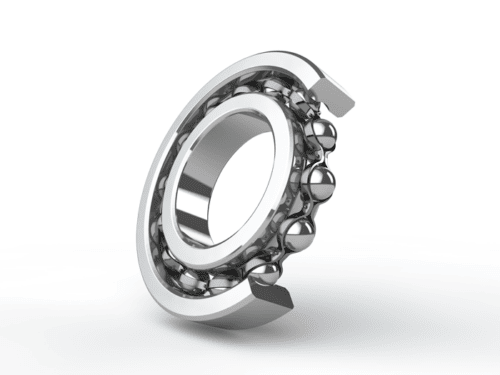
With chrome steel ball bearings, the rolling elements, cage, and races are typically made from stainless or chromium steel. Historically, steel bearings have been the most commonly used across many industries.
Advantages of Steel Bearings
With high load capacities and corrosion resistance (especially for stainless steel), steel bearings are suitable for numerous heavy-duty applications. Advantages of steel bearings include:
- Lower cost
- Durability
- High load capacities
Limitations of Steel Bearings
Steel bearings also have limitations that can lead to diminished performance, including:
- Compromised performance under high operating temperatures
- Fatigue under extreme stress
- Corrosion over time (especially chromium steel)
- Increased friction requiring regular lubrication
A Comparison of Ceramic Bearings vs. Steel
Both types of bearings have relative strengths and weaknesses, including:
- Ceramic ball bearings have a lower coefficient of friction than steel
- Lightweight ceramics enable speeds 20-40% faster than steel
- Ceramic bearings are harder than steel for durability
- Ceramic bearings are resistant to electrical erosion and pitting
- Ceramic bearings have superior corrosion resistance compared to chromium steel but not necessarily to stainless steel
- Maintenance needs may differ between materials and designs
While ceramic bearings have a higher upfront cost, their durability may save money over time. Chrome steel bearings have a lower initial cost but require regular maintenance and may need to be replaced sooner.
Choosing the Best Bearing for Your Needs
Consider these factors when selecting bearings:
- Required load capacity
- Operating conditions including temperature and exposure to corrosion
- Required lifespan
- Rotational speed requirements
- Tolerance for runout deviations
- Lubrication requirements
Emerson Bearing is Here to Help With Your Bearing Selection
Although ceramic hybrid and steel bearings offer their own unique advantages, the right bearing choice will depend on your specific application. At Emerson Bearing, we’re a leading supplier of high-quality ball and roller bearings, as well as bushings, seals, roller chains, belts, couplings, solvents, lubricants, and more. Check out our online bearing selector tool to explore our offerings. For help determining the right bearing for your needs, contact us or request a quote today.
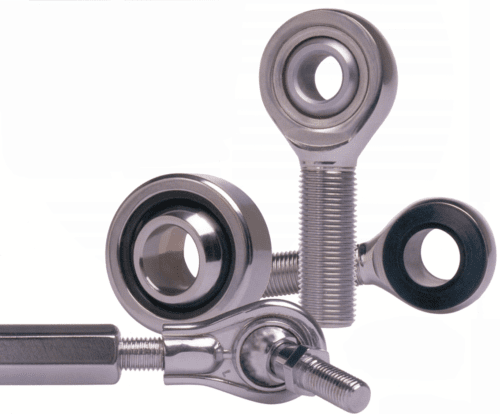 Rod ends consist of an eye-shaped head with an integral shank that serves as housing for a spherical plain bearing, or bushing. They are utilized in linkage applications where a bearing must support a significant misalignment. Rod ends are typically used in the automotive and aerospace industries, but they are also present in a wide range of industrial machinery.
Rod ends consist of an eye-shaped head with an integral shank that serves as housing for a spherical plain bearing, or bushing. They are utilized in linkage applications where a bearing must support a significant misalignment. Rod ends are typically used in the automotive and aerospace industries, but they are also present in a wide range of industrial machinery.
In addition to providing high-quality rod ends, Emerson Bearing also serves the bearing requirements of global and domestic clients. At Emerson Bearing, we are aware that every customer has different needs when it comes to bearings, rod ends and spherical bushings. Whatever type of project you’re working on, our experts can assist you in locating the ideal solution.
What are Rod Ends?
A rod end is a joint that allows for some rotational freedom about all three axes while maintaining a fixed point of contact between two parts. Rod ends are used to join the ends of steering links, control rods, and other mechanically controlled tie rods. Since the center of rotation of a rod end is on the axis of both connected shafts, it offers reliable point-to-point contact.
Many advanced industrial systems require high-precision articulation joints as essential components. These joints are used in a variety of applications, including robotic arms, textile equipment, and automobile steering linkages, among others.
These joints are perfect for circumstances where rotary motion necessitates changes in the rotation axis because they have the capacity to accommodate any kind of misalignment. Since joint systems are utilized worldwide, the rod ends used in them come in metric and inch styles.
What’s the Difference Between Male vs. Female Rod End Bearings?
The threading on a rod end is what determines its classification as either male or female. Rod ends with external threading are male configurations while rod ends with internal threading have a female configuration.
Female rod end bearings are often used in unique applications due to their ability to fine-tune the placement of components. Female rod end bearings, for example, are frequently used in helicopters to precisely adjust the direction of the blade.
High-Precision Rod Ends from Emerson Bearing
Rod ends link the ends of precision articulating joints such as steering links, control rods, tie rods, and more. They are an essential component of many machines, particularly those used in automotive, aviation, and other major industries.
Rod ends come in a variety of styles. The objective is to choose the most appropriate type for your application. Emerson Bearing provides a variety of rod ends and spherical bushings to meet the needs of various industries and applications. Do you need assistance selecting the best rod end for your specific application? Our experts are available to assist you with the selection process. You can also request a quote or call us for more information at 800.225.4587.
From the simplest home appliance to the most complex industrial equipment, precision engineering is essential for safe, reliable moving parts. Connections must allow unrestricted movement, which is where roller bearings come in. Like ball bearings, roller bearings are meant to minimize friction while managing a load, but instead of having point contact, roller bearings have line contact. This gives them greater shock resistance and capacity, and they come in a variety of shapes, including cylindrical, tapered, spherical, and needle profiles, to suit various applications.
Why should you use roller bearings? Take a look:
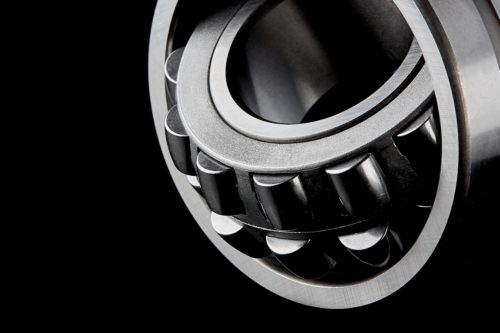
They Are Strong & Durable
Even though ball bearings handle misalignment better than roller bearings, roller bearings can manage more shock and impact. With their larger contact area, they’re designed to be used with larger loads and lower speeds, and each roller bearing shape has its unique advantages. Tapered and spherical roller bearings in particular are best at managing combined radial and thrust loads, for example. Overall, roller bearings are the preferred solution for heavy-load industrial applications.
They Can Be Greased or Lubricated
Even with the right care and maintenance, bearings eventually fatigue to the point of failure, and they should be monitored as part of your regular maintenance program. Predictive maintenance allows you to replace bearings when needed instead of waiting for the entire machine to break down. In the meantime, proper lubrication is key to prolonging the service life of your bearings and ensuring optimum performance of your equipment.
Lubricant serves several functions: 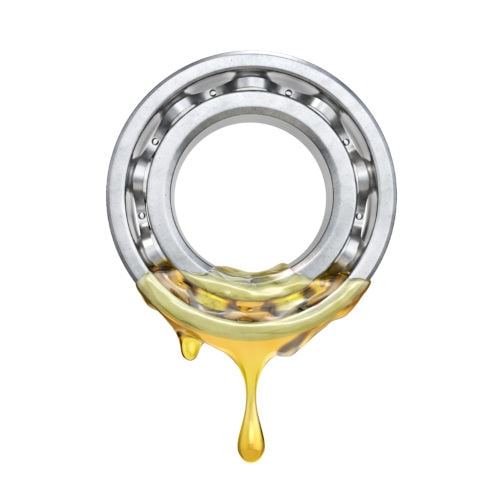
- Reduce friction and wear and tear
- Remove the heat generated by friction
- Cover the contact surface to reduce fatigue
- Prevent corrosion
- Prevent contamination (dirt, debris, etc.)
Proper bearing maintenance includes the right lubricant and lubricating method, which will help your bearings last longer. In some cases, you can take advantage of the latest sealing technology to ensure you don’t have to re-grease your bearings, thereby reducing maintenance requirements.
There Are More Options Based on Geometry
There are different shapes of roller bearings suited to different operations:
- Standard Cylindrical Roller Bearing: They don’t work with thrust loads, but it’s a trade-off for their greater radial load capacity. They’re available in single, double, and multi-row options.
- Needle Roller Bearing: These are similar to the cylindrical bearings, but they have a smaller diameter. This allows the needle roller bearing to be used for operations with less radial space, but it also means the bearing oscillates quickly and produces a lot of friction. Therefore, it’s better suited to slow-moving equipment.
- Tapered Roller Bearings: The tapered shape, which can have an angle of up to 30 degrees, is designed to accommodate thrust loading. The greater the taper, the more axial load the bearing can tolerate. These are most commonly used in pairs.
- Spherical Roller Bearings: Ideal for both axial loading and heavy shock loading, spherical bearings can manage a heavy load even when misaligned.
When choosing the roller bearing for your application, you have to consider loading type and capacity, as well as any lubricant or sealing and shielding requirements. However, the choice between ball bearings and roller bearings is somewhat more straightforward: choose ball bearings for light loads and fast speeds, and choose roller bearings for heavy loads and high impact operations.
At Emerson Bearing, we have years of experience with precision bearing manufacturing for industries like mining, material handling, food processing, transportation, recreation, robotics, wastewater treatment, plastic processing, power generation, and more. We can help you determine which bearings are right for your application. Contact us to learn more about the benefits of roller bearings or to request a quote for your project.
At Emerson, we have over 50 years of experience creating high-quality ball bearings and roller bearings for commercial and industrial applications. Through both Emerson Bearing and Action Bearing, we’re proud to serve markets around the world. Emerson Bearing services niche international markets, and our New England customers are served by Action Bearing, which specializes in Original Equipment Manufacturer (OEM) and Maintenance, Repair, and Operations (MRO) solutions.
Customer satisfaction is our top priority. We serve our customers by ensuring each one gets the right high-quality bearings and services at the best available price for their budget.
Key Factors to Know
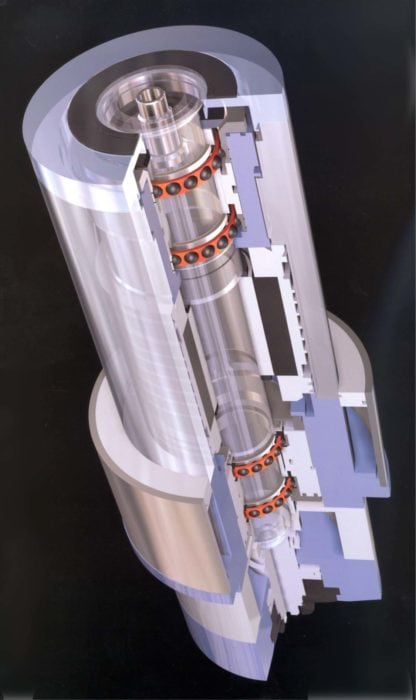
When you’re choosing ball or roller bearings for your next project, there are three key factors to keep in mind: contact angle, preload, and system rigidity.
1. Contact Angle
This is the line of contact along which the ball bearing touches the raceways of the assembly. This angle is determined by the thrust loading and radial play. Ideally, the contact angle should be 15°—this is the optimal balance between axial and radial capacity and rigidity. To increase the axial rigidity, some systems have a contact angle of 25°. No matter which angle works best for your system, it’s essential to choose the bearings that operate best at the given angle.
2. Preload
Preload is a force that holds the raceway and rolling element surfaces under pressure. It’s a constant elastic compressive force that stops the parts from moving in an uncontrolled manner —either axially or radially—even when they’re under load. The right bearings will tolerate this additional force without breakage.
3. System Rigidity
Machine tools generate several different forces that ball and roller bearings need to be able to account for. Factors such as housing stiffness and bearing stiffness determine the machine’s system rigidity and ability to produce consistently precise results.
Maintenance and Care
All bearings have a pre-determined bearing life, or a maximum number of rotations the bearing can undergo. These rotations impact the inner rings, outer rings, and rolling elements with constant load, which leads to inevitable wear. Factors that can lead to excessive wear and shorten the effective lifespan of the bearings include:
- Inefficient or full contact seals. The more contact a bearing has with a seal (such as a full contact seal) or the less calibrated a seal is, the more wear the bearing will undergo. This can wear the sealing element as well as the bearing.
- High speeds or speed changes. If the bearing is operating at excess speeds, the friction can quickly wear through a bearing. Also, excess speeds can increase sliding speed, which causes uneven wear. If the operation speed changes too quickly, that will increase the slip and wear.
- Poor environmental conditions. Dirt, dust, and other foreign particles can scratch the ball bearing’s surface and cause wear. The presence of water can also corrode the surface, leading to poor performance and a shortened lifespan.
With proper maintenance and care, operators can extend the life of bearings to reach or exceed the recommended service life. Two of the most important parts of caring for ball and roller bearings include cleaning the bearings and reapplying grease. Incorporate these tips to extend the equipment’s lifespan:
- Grease storage. Always keep grease tins closed when not in use and keep the containers in a separate storage environment with stable temperatures. We recommend not using grease that’s more than three years old.
- Grease application. Once the bearings have been cleaned and completely dried, apply grease over the balls and rings. Be sure an equal amount of grease gets between the balls in the inner ring. To ensure the grease is as clean as possible, always apply it with clean spatulas or with clean plastic syringes for precise applications.
Working With an Industry Leader in Emerson
We know that getting the best possible performance out of your equipment relies on having high-quality ball and roller bearings from the start. Our team is here to help you find the bearings with the right specifications for your facility’s sensitive tools and equipment. We maintain an extensive inventory of bearings for countless high-speed and high-precision applications. Our selection also includes next-generation bearings made from specialty steels.
If you want to ensure maximum performance of your equipment’s bearings, start with a professionally sourced, high-quality selection from the international experts at Emerson. We can help your team find the ideal ball and roller bearings for any application to ensure a long service life. To see how our team can help with your bearing selection process, please contact us.
Precision slewing ring bearings are a type of angular bearing that consists of two concentric rings with balls or rollers that enhance movement in load-bearing and power transmission applications. The two rings may be constructed with toothed gears to increase torque and can facilitate movement in any direction from the center of the bearing. They are ideal for use in low-speed, heavy load applications such as construction and excavation, or more intricate and precise such as medical tools and devices. Overall, there are many benefits to using precision slewing rings bearings.
Key Benefits and Difference of Precision Slewing Ring Bearings
Slewing ring bearings offer a number of unique benefits over other ball and roller bearings, especially for heavy load applications that require great freedom of movement. 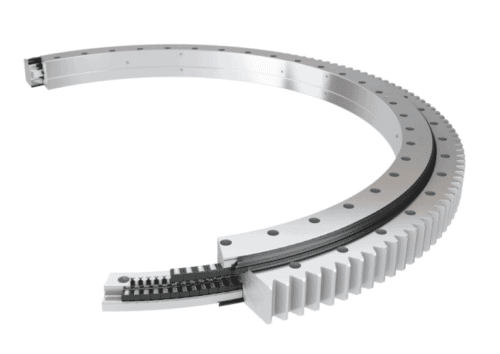
- Versatile Load Spectrum:Slewing ring bearings provide 360-degree joint support for complex load bearing systems, which allows for concurrent movement on multiple axes.
- Shaftless Design:Slewing rings are designed to operate without a shaft or spindle, thereby enhancing bearing motion and allowing space for additional operational components.
- Load Carrying Capacity:Slewing ring bearings are designed to handle the movement of heavy loads with great efficiency.
- Ideal Stiffness:Although they are designed to facilitate a wide range of motion, slewing ring bearings exhibit high material stiffness to ensure sufficient support in rigid bearing applications.
- Low Friction:Slewing bearings are particularly valuable for their low-friction and freedom of movement, which enhances process efficiency while increasing the service life of the bearing and surrounding equipment.
- Extended Service Life:Slewing ring bearings offer a highly durable, low friction load-bearing option that reduces the stress and friction on the bearing and interacting components. The reduced equipment wear helps to extend the service life of the bearing and the system as a whole.
Applications of Precision Slewing Ring Bearings
The versatility and efficiency of slewing ring bearings makes them ideal for use in a range of industries and applications, from military and defense equipment to manufacturing and transportation. Common applications include:
- Military and Defense: Slewing ring bearings are often used in military and defense equipment that must direct heavy loads with a high degree of precision. They can be found in missile launchers, tank turrets, and optical devices, among many others.
- Construction: The construction industry benefits from the use of slewing rings, particularly in load-bearing and lifting applications, such as lifts, cranes, hydraulic excavators, and borers.
- Bottling Technologies: The 360-degree rotation of slewing rings makes them especially useful for industrial bottling applications including sanitization, washing capping, and labeling functions.
- Mining:Slewing rings are frequently used in mining excavation and tunnel boring, where equipment must be able to move freely under heavy loads.
- Transportation: Trains, trams, and subways often use slewing rings to facilitate free and easy vehicle movement.
- Tooling and Machining: Slewing ring bearings are often used to facilitate movement in precision machine tools. They allow for free multi-axis movement of machine tool spindles in precision milling and turning applications.
Bearing Maintenance and Care
Although slewing ring bearings may require less maintenance than other bearing designs, they can often suffer damage and failure due to insufficient or incorrect lubrication. When mounting bearings, it is important to ensure that you are greasing your rings with solid lube during the pre-mount phase. Post mount lubrication and maintenance should be regularly scheduled to ensure the service life of your bearings.
In addition to ensuring the correct lubrication, it is important to regularly check for debris, dirt, and other contaminants in the lubricant, as they can abrade or wear down your bearings, thereby reducing the service life and increasing repair and replacement costs.
If your slewing ring bearing is mounted on an uneven or easily distorted surface, the weight of the loads will be unevenly distributed on your bearing. This can result in localized wear and tear, further reducing the bearing’s service life. To prevent undue wear on your bearings, try to ensure that they are operating on a flat, strong surface.
Precision Slewing Rings by Emerson Bearing
At Emerson Bearing, we have 50 years of experience in providing superior quality bearings for our customers around the world. Our highly experienced staff has the knowledge necessary to ensure you have the perfect bearing design and material for your application. To learn more about our precision slewing ring bearings and how they can improve your operations, request a quote today!











 Rod ends consist of an eye-shaped head with an integral shank that serves as housing for a spherical plain bearing, or bushing. They are utilized in linkage applications where a bearing must support a significant misalignment. Rod ends are typically used in the automotive and aerospace industries, but they are also present in a wide range of industrial machinery.
Rod ends consist of an eye-shaped head with an integral shank that serves as housing for a spherical plain bearing, or bushing. They are utilized in linkage applications where a bearing must support a significant misalignment. Rod ends are typically used in the automotive and aerospace industries, but they are also present in a wide range of industrial machinery.






